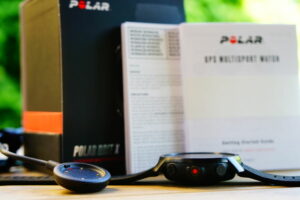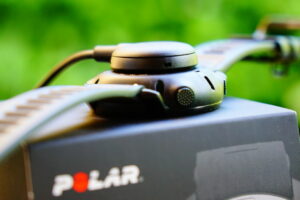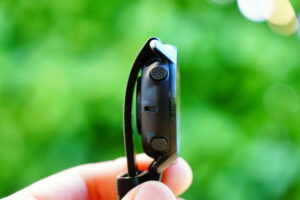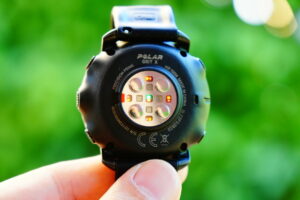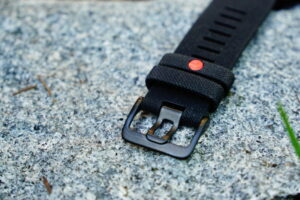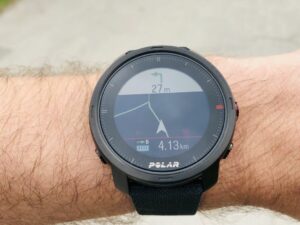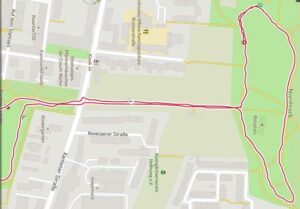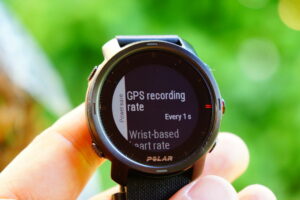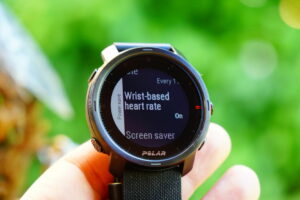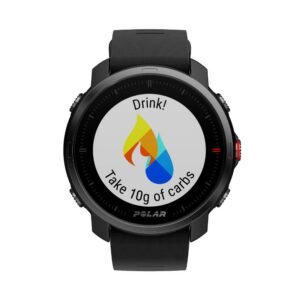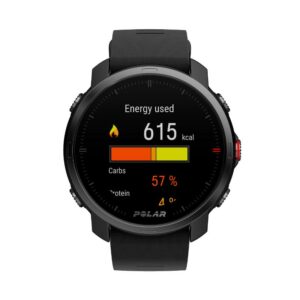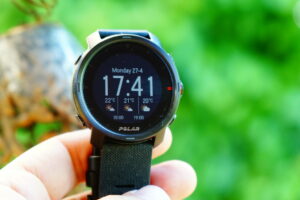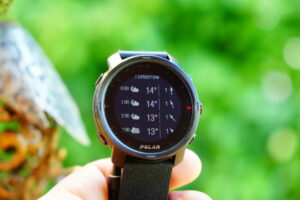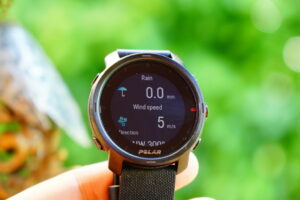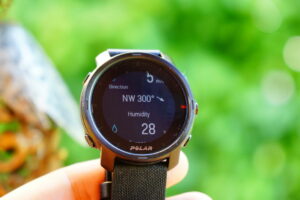In our Polar Grit X review, we look at the outdoor multi-sport watch with up to 100 hours of battery life in training mode including GPS. It is available from $429,95 RRP and comes with familiar and new functions. We already had several weeks with our test device to gain first experiences and impressions, which are very good so far.

Bestsellers, deals, gift ideas*
The Highlights
With the Polar Grit X, the Finnish sports watch specialist launches a multi-sports watch that is specially designed for outdoor sports. With the highlighting “Tested according to military standards” (according to “MIL-STD-810“) Polar wants to make it clear: Here you get a sports watch that defies even extreme weather conditions and feels great outdoors.
Among the highlights are new features that are not available on other Polar models:

New
- Hill Splitter: Uphill and downhill analysis of activity.
- FuelWise: an assistant for energy reserves.
- Komoot support: plan routes and use them for turn-by-turn navigation on the display.
- Multiple battery power saving options to extend battery life up to 100 hours in training mode with GPS. To find out exactly which modes are available, see our Polar Grit X review below.
- Weather Forecast: the watch can display current weather data as well as a weather forecast for the next 2 days.
- Water resistant up to 100 meters (WR100).
- At 64 grams, one of the lightest and most robust outdoor multisport watches available.
Further
- Always-On Color Touch Display
- Battery life: up to 40 h in training mode (GPS and pulse measurement on wrist) or up to 7 days in watch mode including 24×7 heart rate measurement.
- FitSpark: like the Unite, Ignite and Vantage models M and V, the Grit X provides new training goals every day based on recovery, daily form and training history. The suggestions come from the categories cardio training, strength training and supportive training.
- Nightly Recharge: determines how well you recover from stress and training at night and offers practical training tips for the following day. Based, among other things, on measuring heart rate variability (HRV).
- GPS, compass, barometric altimeter.
- Training plans
- Swim metrics: Pulse, swimming style, distance, speed, swim stroke and rest periods. For open water swimming: only distance and strokes.
- 24×7 tracker for sleep, steps, calories, heart rate.
- Quick Release Wristbands: interchangeable without tools with any other watch strap with 22mm spring bars.
- And much more
 | Polar Grit X Price | |
Design
One thing you have to give the Polar Grit X credit for: it comes as a surprise and it’s also chic. After the first impressions in our review, we ask ourselves the question about the reason for the existence of the still quite current Vantage models. The M-version is very interesting in terms of price if some missing features are not so important, see our comparison table below. The Polar Ignite and the newer Unite have a different target audience and clearly play in a lower league in terms of processing materials.
The Grit X is the closest haptic comparison to the Vantage V. This is due to the stainless steel housing, the display, and the very well tactile, rippled, mechanical 5 keys, which come along with a good pressure point. But when comparing the displays directly, there seem to be differences. See the section Display, also the charging cable was carried over and can charge both devices.
On smaller wrists, the newcomer might be a bit larger, but you should try this for yourself because it is not really massive.
Compared to the more expensive Vantage V, the Grit X is ahead in many ways. At 64 grams, it is 2 grams lighter, waterproof (WR100 instead of WR50), and equipped with a cool, one-sided ribbed sports band that can be changed very quickly and without tools using Quick Release.
The overall design has a high-quality effect and the wearing comfort is excellent. All in all, there is hardly a reason not to use the Grit X. Furthermore, it is equipped with an almost identical feature set and has more features. In addition, the Vantage series will probably not get any more and therefore none of the newer features, if one can trust Polar’s statement. It says that they have received the last planned feature update with the 5.0 update. There is nothing more to come.
The only thing missing from Grit X is Recovery Pro and the option for an orthostatic test. So if you need more in-depth analysis for recovery, you’ll still have to use Vantage V. However, to fully enjoy all Recovery Pro advantages, you will need to purchase a compatible HR chest strap (e.g. Polar H10).
Polar Grit X: Display
In our Polar Grit X review, there is hardly any delay on the display during operation. The displays change smoothly, quickly and smoothly as soon as a button is pressed. This also applies to the touch operation, which, however, does not always react reliably if you lack experience with it. With frequent touch use, it hardly smears at all, existing smear marks are hardly visible.
At 1.2 inches, the display is comparable to that of the more expensive Vantage V. Because the Grit X also comes with a color touch display with a resolution of 240 x 240 pixels. But when comparing the displays directly, there seem to be differences. Because apparently the display now appears sharper and brighter. Also, the backlighting now seems more powerful, especially in darker environments.

The display does not offer such rich colors as an AMOLED display of a Garmin Venu or Apple Watch, for example, which certainly masterfully implement this. In contrast to these, however, it feels very comfortable outdoors and in bright environments and is very good and easy to read. It also makes a much better battery life possible.
Furthermore, it is permanently on (Always-On Display), which is not the case with the watches mentioned above. The only backlight has to be activated in darker environments, because then the display becomes more difficult to read, similar to a transflective MIP display of a Garmin Vivoactive 4 or Garmin Fenix 6. However, the automatic system switches the backlight on quite reliably when the arm is moved accordingly. The illumination can also be activated permanently for workouts:
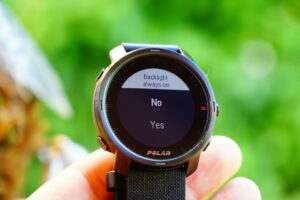
A little finesse on the side: the backlighting activated by the automatic is much weaker compared to the lighting that can be manually activated with the upper left key, but is completely sufficient for reading the time. This avoids feeling disturbed by the frequently active backlight, for example in the bedroom. If this is not sufficient, the mentioned key considerably increases the illumination.
Grit X Test: Routes & Komoot Turn-by-Turn-Navigation
In our Grit X review, we also take a closer look at the integration of Komoot. This is not really new at Polar, because the Vantage V can also synchronize with routes. However, it cannot do turn-by-turn navigation.
Komoot offers, among other things, a popular route planner with which you can easily plan routes for hiking, running, or cycling activities. Furthermore, there are also ready-made routes. These can be transferred to the Grit X and used for turn-by-turn navigation on the display. How this is realized on the Grit X can be seen in the pictures below.
| Routes | Komoot Routes | |
|---|---|---|
| Route type |
| Komoot Routes |
| Turn-by-Turn | No | Yes |
| Visuelle Route auf Display | Yes | Yes |
| Navigation Arrow | Yes | Yes |
| “Wrong direction” hints | Yes | Yes |
| Display remaining distance | Yes | Yes |
| Selectable GPS recording rates |
| 1 Second |
| Selectable route starting points |
|
|
In Flow you can also upload routes via *.gpx or *.tcx files and follow them visually on the watch in the form of green lines as shown in the pictures below. These can be self-created or predefined routes of other services. However, these are not supported by the turn-by-turn navigation. In practice, this ultimately means that the turn-by-turn instructions and alarms (by vibration, visual and acoustic) are missing, which are only found on routes imported from Komoot, usually about 30 meters and immediately before a turn.
The only important warning for self-imported routes is the “Wrong direction” warning. This is the warning that the watch will give if you leave the planned route or take the wrong direction. At least the planned path can be covered more safely.
A bit annoying in the practical test was that the watch insists that the selected route starting point is recognized by it. Otherwise, the actual route guidance is not activated. An example: if the route starting point was selected as the starting point, then this is to be looked up also precisely and it is to be made certain that the watch announces the message “route starting point found”. It does not recognize an entry 50 meters further, even within the planned route. At least it guides you to the selected starting point with the help of an arrow and a distance indication, so that you can get started.
Komoot Setup
The following things were possible with a free Komoot account. Among other things, this allows the choice of a first, free region. For the activation of further regions costs arise depending upon need. After the account has been set up and the Komoot app has been installed, the connection between Flow and Komoot can start.
In the Polar Flow app, a new option for connecting to Komoot is activated as soon as the Komoot app is recognized. At least this is how it was on our iPhone. Alternatively, the process can also be done in the Flow Webservice via browser in the profile settings under partner, which was silent and uncomplicated.
Komoot routes and navigation
In Komoot we plan and save with a few clicks a small, own 5km round trip, which we want to test on the Grit X. The route goes through the city, parkways and paths not marked in maps. If you want to reduce waiting times for synchronization with Flow, you can click a synchronization button (blue arrows in the screenshot below) in the Flow webservice under Favorites. We could not detect this button in the Flow app. Once clicked, the routes saved in Komoot appear immediately in Flow.
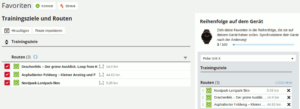
The next time you synchronize with the Grit X, the routes marked as favorites in Flow will be available on the Grit X. They can be accessed in the sport profiles in the respective settings menu. There are the item Routes, which provides all synchronized routes. When a route is selected, a map symbol appears next to the selected sports profile. The start of the activity activates a new display for the route view. Real map material such as on a Garmin Fenix 6 is unfortunately not shown on this display.
In the route view, the remaining distance to the destination can also be read in the lower display area. Furthermore, route hints are now also active. For example, 30 meters before a turning point a vibration alarm is given, and the first acoustic and on the display readable indication of the turn-by-turn navigation. Almost exactly before you have to turn, there is an additional “Turn now” message. This worked reliably at all times during the test, regardless of the current location.
We also consider this to be an indication that the watch has a precise GPS receiver. This is also supported by an almost identical distance measured at the end of the activity to the planned route distance.
By the way, the route view does not always have to be active for turn-by-turn navigation. This means that you can switch back and forth between existing displays. As soon as you have to turn, the upper part of the display will continue to indicate this.
We have also tested how the Grit X reacts to leaving a route. After about 30 meters, the Grit X notices this and warns you. As you can see in the picture on the right, a new view is activated, which shows directions to return to the route and the distance to the route. As soon as the planned route is resumed, the grit will continue as normal. Overall, we are satisfied with the implementation of the route guidance.
Komoot restrictions
If a Komoot route is activated, the GPS recording rate per second must be active. This means that the battery power saving functions of the GPS recording rates of 1 or 2 minutes cannot be used. This is also logical because for reliable turn-by-turn navigation and timely turn-by-turn instructions, accurate positioning is essential. This would not be possible with lower GPS recording rates.
Sports Tests: heart rate monitor, GPS
With constant running units, the Grit X leaves a good impression in our review. At the same time, the Polar H10 chest strap was worn for a first jogging unit to counter measure. Here is the result, as you can see, the almost training-free time in the crisis has left its mark:
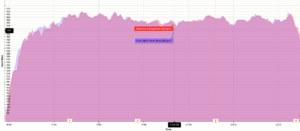
“We always consciously start a training session without warming up, to praise a sports watch if it measures accurately from start to finish. However, this happens rarely”, we once wrote. Interestingly, the often typical accuracy problems of optical pulse sensors are not visible in the first minutes of activity with the Grit X. We also saw how the Vantage V tested had initial problems, which can be avoided by warming up properly. Whether the Grit X does it better because it has one more LED than the Vantage and more orange instead of green LEDs would need to be clarified. It’s clear that the Grit X pulls along with the HR chest strap right from the start of the test.
The average HR values in the overview:
| Polar Grit X | Polar H10 | |
| HR Average (S/min) | 156 | 156 |
| HR Max. (S/min) | 168 | 169 |
Here is a comparison from a second, similar run:
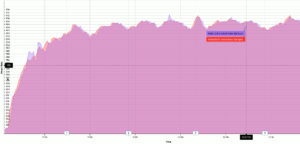
| Polar Grit X | Polar H10 | |
| HR Average (S/min) | 161 | 161 |
| HR Max. (S/min) | 173 | 172 |
Let’s take a look at how exactly the Polar Grit X processes GPS data. All in all, it displays routes properly and stays within the 10 to 15 meters of tolerance allowed to GPS receivers in the consumer segment.
The fact that we consider the GPS receiver to be precise was also explained in the Komoot section. This is because planned turns were reported very precisely in terms of time, and distances measured by the watch come very close to planned route distances: about 60 meters less for a planned 5.05 kilometers.
Battery and energy-saving modes
Testing battery life every day
The battery life of the Grit X in everyday use is impressive and corresponds approximately to the manufacturer’s specifications. Keep in mind that this watch has an always-on display. For a start, we looked at how long it lasts when all features are active and the following conditions apply:
- 24×7 tracker (activity tracker, sleep tracker, heart rate measurement)
- Smartphone News
- Every 2 to 3 days training at about 30-45 minutes (animated FitSpark strength exercises, GPS activities)
We can only estimate the actual battery life for these conditions. This is because the Grit X will go into some kind of energy-saving mode when the battery level is about 5% remaining.
This mode only allows you to read the time and possibly hours or days of battery life. All other functions and sensors are switched off. Therefore it is not possible to say exactly how long the battery would have lasted until the watch was switched off. It is estimated that the battery would last about 6 to 7 days with use of all functions and regular training.
Energy-saving modes
Similar to the Garmin Fenix 6, the Grit X supports various battery saving options. These go so far that about 100 hours of battery life in training mode with GPS are possible. Once activated, the energy-saving options have a variety of effects.
The energy-saving options that can be influenced include settings for the GPS recording rate and the integrated heart rate monitor. In addition, a kind of screen saver can ensure a minimum of display activity by only showing the time during activities. When the screen saver is active, all training data can be displayed for 8 seconds before disappearing from the display.
Once a change has been made, the watch will show the effect on the remaining battery life. This means that athletes can quickly estimate how long the watch will last. However, it does not remember the settings and must be reconfigured when starting a new activity.
On the one hand, instead of the 40 standard hours, it is now possible to record about 60, 65 or even 100 hours of GPS tracks. With deactivated GPS, even more than 242 hours are possible. On the other hand, depending on the selected option, GPS tracking points are recorded less often (1 minute, 2 minutes or off), less data is shown on the display or the optical heart rate sensor is deactivated completely. Alternatively, an HR chest strap can be permanently integrated.
The 100 hours can be reached with a full battery and the following options:
- GPS recording rate: 2 minutes
- Optical heart rate monitor: Disabled (alternatively use more energy-saving Bluetooth HR belt instead)
- Screen Saver: Enabled
Hill Splitter
Hill Splitter is used on the Grit X for the first time. No other Polar watch currently offers this feature. Simply put, Hill Splitter specifically analyzes uphill and downhill sequences.
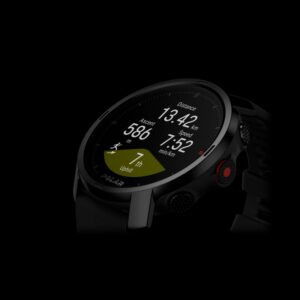
It automatically recognizes ascents and descents using various metrics such as speed, distance, and altitude data and divides them into an uphill and a downhill sequence. In doing so, it provides statistics for this sequence. The number of ups and downs of an activity are also counted.
The Hill Splitter provides a detailed overview of the performance during strenuous altitude-heavy activity sequences. The corresponding performances can thus be compared and improvements made visible.
FuelWise
FuelWise is also a Polar feature available on the Grit X for the first time. It is a configurable assistant that helps you to keep an eye on your energy reserves and to refill calories and fluids in time, especially during longer sports activities.
FuelWise also tries to keep track of current performance data and estimates calories burned in order to alert appropriately. During activity, the watch provides both audible and vibrational alerts, allowing athletes to refuel before performance slows down due to a lack of nutrients. In the Polar Grit X test, we will also take a closer look at this function.
Weather
The Grit X is the only Polar watch that supports the display of current weather data for the next hours. In addition, it also shows a weather forecast for the next 2 days if required.
The new display shows data on maximum and minimum temperatures, wind speed, probability of rain and humidity.
Polar Grit X vs Vantage vs Ignite vs Unite
In a separate article, we will offer a detailed Grit X vs Vantage comparison with important and worth knowing things. It helps to decide which model is the right one for you. Below is just a quick comparison between Vantage, Ignite and the newer Unite for orientation.
Polar Grit X Review: Conclusions
On the basis of our previous Polar Grit X experiences, we allow ourselves some conclusions:
- Overview
- Test equipment/-log
What we like
- Suitable for beginners and advanced users
- Versatile and including successful training plans
- Turn-by-Turn Navigation
- Accurate 24×7 tracker
- Comprehensive overview of fitness status
- Battery life
What we like less
- The display is difficult to read in very dark environments without activated display illumination
- Handling isn’t always intuitive (e.g. immediate start of an activity)
With the Grit X, Polar has launched a rock-solid sports watch and has not repeated the mistakes made when introducing the Vantage series, for example, features that were only delivered later. There are very few reasons to choose the Vantage V, as the Grit X is ahead in almost every aspect. It’s sporty, versatile, and precise enough to impress us. We were also pleased with the simple turn-by-turn navigation and the reliable 24×7 features.
If you want to configure sport profile yourself down to the smallest detail, look at the Garmin Fenix 6 as an alternative, or if fewer functions are enough, then the Polar Vantage M, which is now available at a reasonable price.
Additional equipment used in this test report:
- Polar H10 chest strap
- iPhone 8 Plus (iOS 13)
Polar Grit XTest: Change Log:
- 17.11.20: First Test (Route planning, battery life, GPS, hr measurement, …)
Polar Grit X: Prices and availability
The Polar Grit X is now available in different colors. It costs $429,95 RRP.
 | Polar Grit X Price | |
